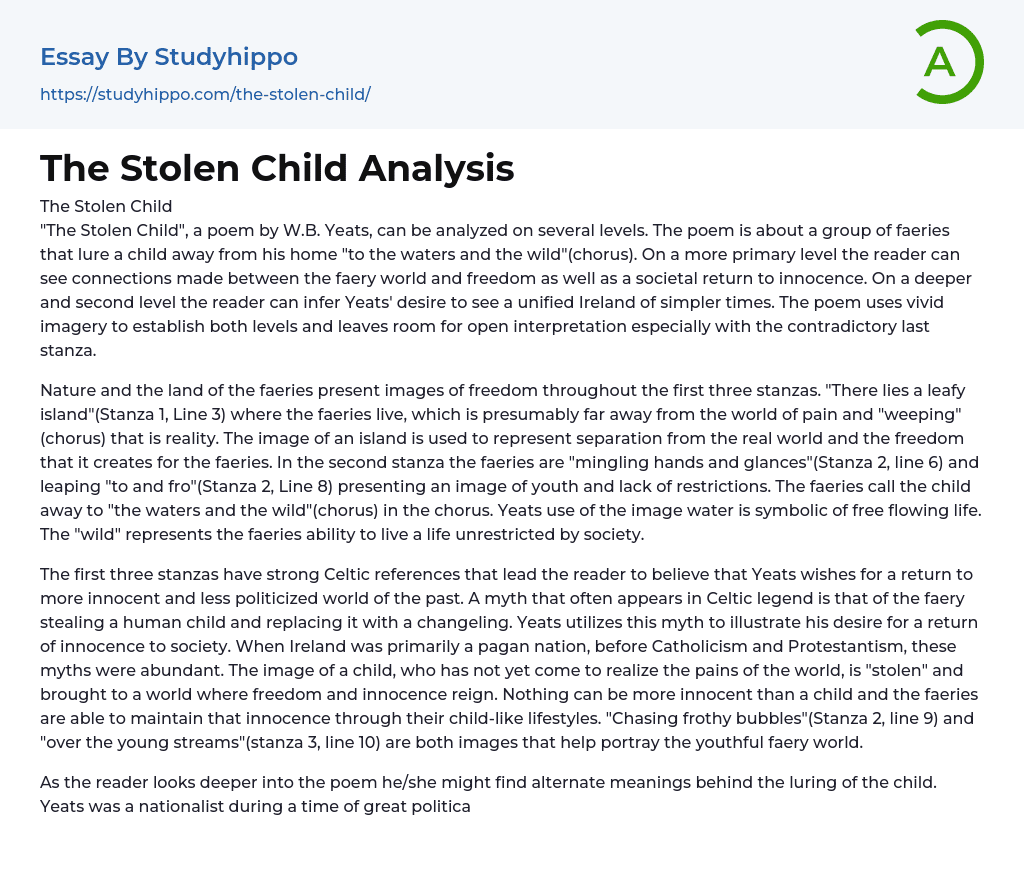The Stolen Child
"The Stolen Child", a poem by W.B. Yeats, can be analyzed on several levels. The poem is about a group of faeries that lure a child away from his home "to the waters and the wild"(chorus). On a more primary level the reader can see connections made between the faery world and freedom as well as a societal return to innocence. On a deeper and second level the reader can infer Yeats' desire to see a unified Ireland of simpler times. The poem uses vivid imagery to establish both levels and leaves room for open interpretation especially with the contradictory last stanza.
Nature and the land of the faeries present images of freedom throughout the first three stanzas. "There lies a leafy island"(Stanza 1, Line 3) where the faeries live, which is presumably far away fr
...om the world of pain and "weeping"(chorus) that is reality. The image of an island is used to represent separation from the real world and the freedom that it creates for the faeries. In the second stanza the faeries are "mingling hands and glances"(Stanza 2, line 6) and leaping "to and fro"(Stanza 2, Line 8) presenting an image of youth and lack of restrictions. The faeries call the child away to "the waters and the wild"(chorus) in the chorus. Yeats use of the image water is symbolic of free flowing life. The "wild" represents the faeries ability to live a life unrestricted by society.
The first three stanzas have strong Celtic references that lead the reader to believe that Yeats wishes for a return to more innocent and less politicized world of the past. A myth that often appears i
Celtic legend is that of the faery stealing a human child and replacing it with a changeling. Yeats utilizes this myth to illustrate his desire for a return of innocence to society. When Ireland was primarily a pagan nation, before Catholicism and Protestantism, these myths were abundant. The image of a child, who has not yet come to realize the pains of the world, is "stolen" and brought to a world where freedom and innocence reign. Nothing can be more innocent than a child and the faeries are able to maintain that innocence through their child-like lifestyles. "Chasing frothy bubbles"(Stanza 2, line 9) and "over the young streams"(stanza 3, line 10) are both images that help portray the youthful faery world.
As the reader looks deeper into the poem he/she might find alternate meanings behind the luring of the child. Yeats was a nationalist during a time of great political upheaval in Ireland. Nationalists wanted Ireland return to years before when Ireland was considered one nation. The Celtic images of the past could represent a desire to return to a time where Ireland was united. The freedom that the faery world allows is representative of the freedom that unity throughout Ireland allowed before religion and politics became large issues.
Yeats purposely allows for interpretation throughout the poem especially within the last stanza. In the first three stanzas the world of the faeries is portrayed as wild and free while the world of the child is "full of weeping"(chorus). However the last stanza tells of "calves on the warm hillside"(stanza 4, line 3) and the "kettle on the hob"(stanza 4, line 5) all comforting images only found
in the world of the child. This contradiction is used to show the ambiguity between the lines of good and evil. The images may be domestic and representative of current society however the reader was lead to believe previously that society needed to return to a simpler existence. In the last stanza Yeats shows that perhaps we cannot only look to the past for fear of loosing the comforts of today.
The title of the poem also proves to be contradictory. The child is first lured by a wonderful life in the first three stanzas, however in the end the child must be "stolen" in order to bring him to "the waters and the wild". This furthers the idea that perhaps current society isn't completely wrong and we must again look at how ambiguous the lines of good and evil are. First the faeries could be seen as nothing but free and positive. In the last stanza they have stolen a child away from his comforting childhood.
Yeats utilizes his poem "The Stolen Child" to convey his dissatisfaction with society but he also proves that there is no simple solution to any of the society's problems. In the end there are no clear answers as to what Yeats was ultimately saying. He was likely writing about two contradictory feelings. He appears to be torn between wanting to return to a more unified and free society of the past while not abandoning the domestic comforts of the present.
- Book Summary essays
- Metaphor essays
- Reader essays
- Rhyme essays
- Literary devices essays
- Villain essays
- Books essays
- Genre essays
- Literary Criticism essays
- Writer essays
- Protagonist essays
- Simile essays
- Poem essays
- Book Report essays
- Book Review essays
- Greek Mythology essays
- Plot essays
- Tragic Hero essays
- Coming of Age essays
- Play essays
- Rhetoric essays
- Rhetorical Question essays
- Translation essays
- Understanding essays
- Reason essays
- Character essays
- Letter essays
- American Literature essays
- Literature Review essays
- Utopia essays
- Poetry Analysis essays
- Dante's Inferno essays
- Between The World and Me essays
- Incidents in The Life of a Slave Girl essays
- Flowers for Algernon essays
- Myth essays
- Everyday Use essays
- Boo Radley essays
- Genesis essays
- Richard iii essays
- Alice in Wonderland essays
- On the road essays
- Ozymandias essays
- The Nightingale essays
- Holden Caulfield essays
- Animal Farm essays
- 1984 essays
- A Hanging essays
- Shooting An Elephant essays
- A Tale Of Two Cities essays




